The Role of Culture in International Business: A Research Report
VerifiedAdded on 2020/03/23
|12
|2773
|142
Report
AI Summary
This report delves into the crucial role of culture in international business, examining how cultural differences in communication, etiquette, and organizational hierarchy impact global ventures. The research highlights the importance of understanding cultural nuances to navigate international markets successfully. The report explores the challenges and opportunities presented by globalization, emphasizing the need for businesses to adapt their strategies to accommodate diverse cultural perspectives. It provides insights into how cultural factors influence negotiation, marketing, and overall business operations, using examples from various countries and regions. The study underscores the significance of cultural awareness and sensitivity for fostering effective cross-cultural communication and building strong international relationships. The report also provides recommendations for businesses expanding into new markets, emphasizing the need for thorough market analysis and adaptation to local cultural norms. The report uses the example of Young Digital Planet to illustrate how cultural differences affect business practices. The research concludes by emphasizing the influence of culture on marketing strategies, negotiation processes, and pricing, reinforcing the need for businesses to consider culture as a vital factor for success in the global marketplace.
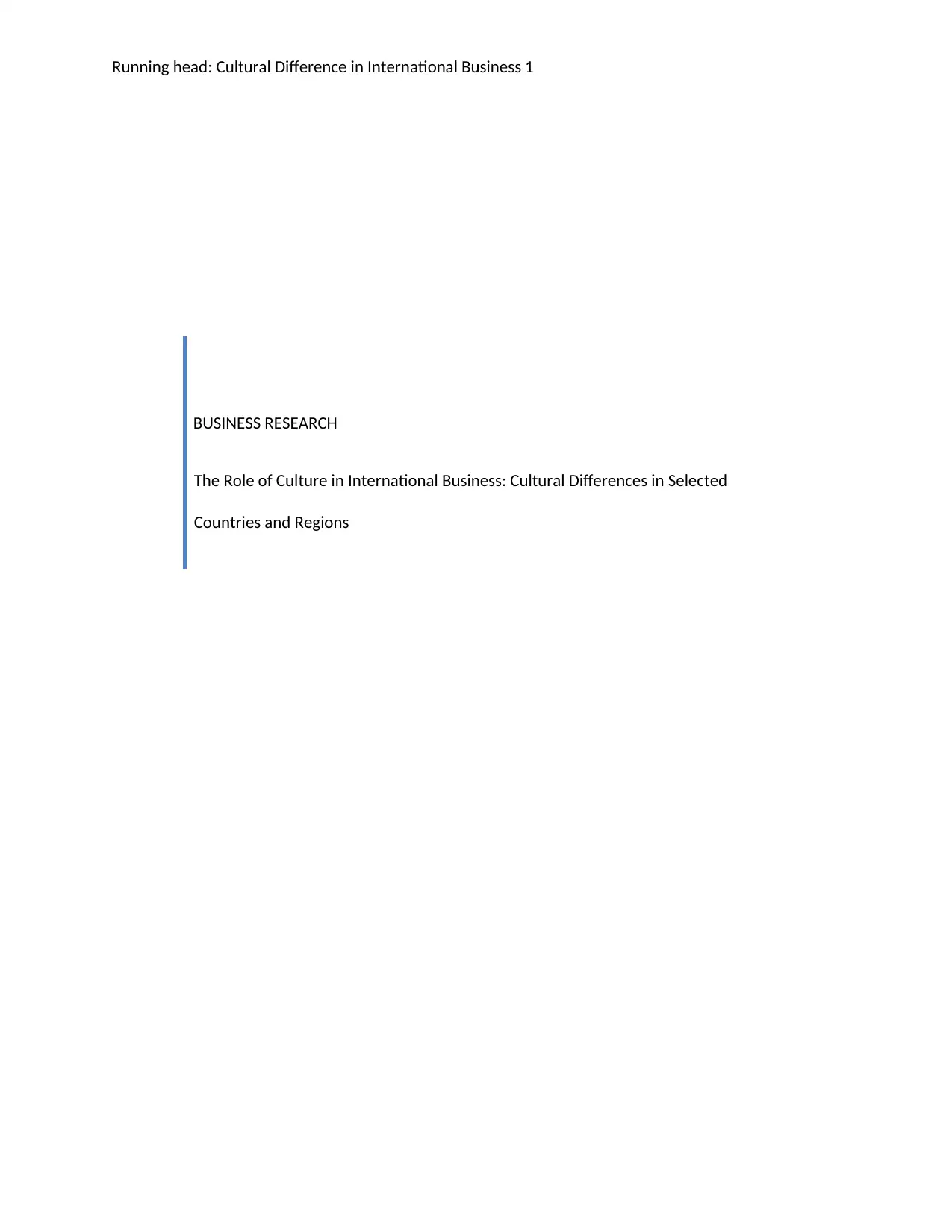
Running head: Cultural Difference in International Business 1
BUSINESS RESEARCH
The Role of Culture in International Business: Cultural Differences in Selected
Countries and Regions
BUSINESS RESEARCH
The Role of Culture in International Business: Cultural Differences in Selected
Countries and Regions
Paraphrase This Document
Need a fresh take? Get an instant paraphrase of this document with our AI Paraphraser
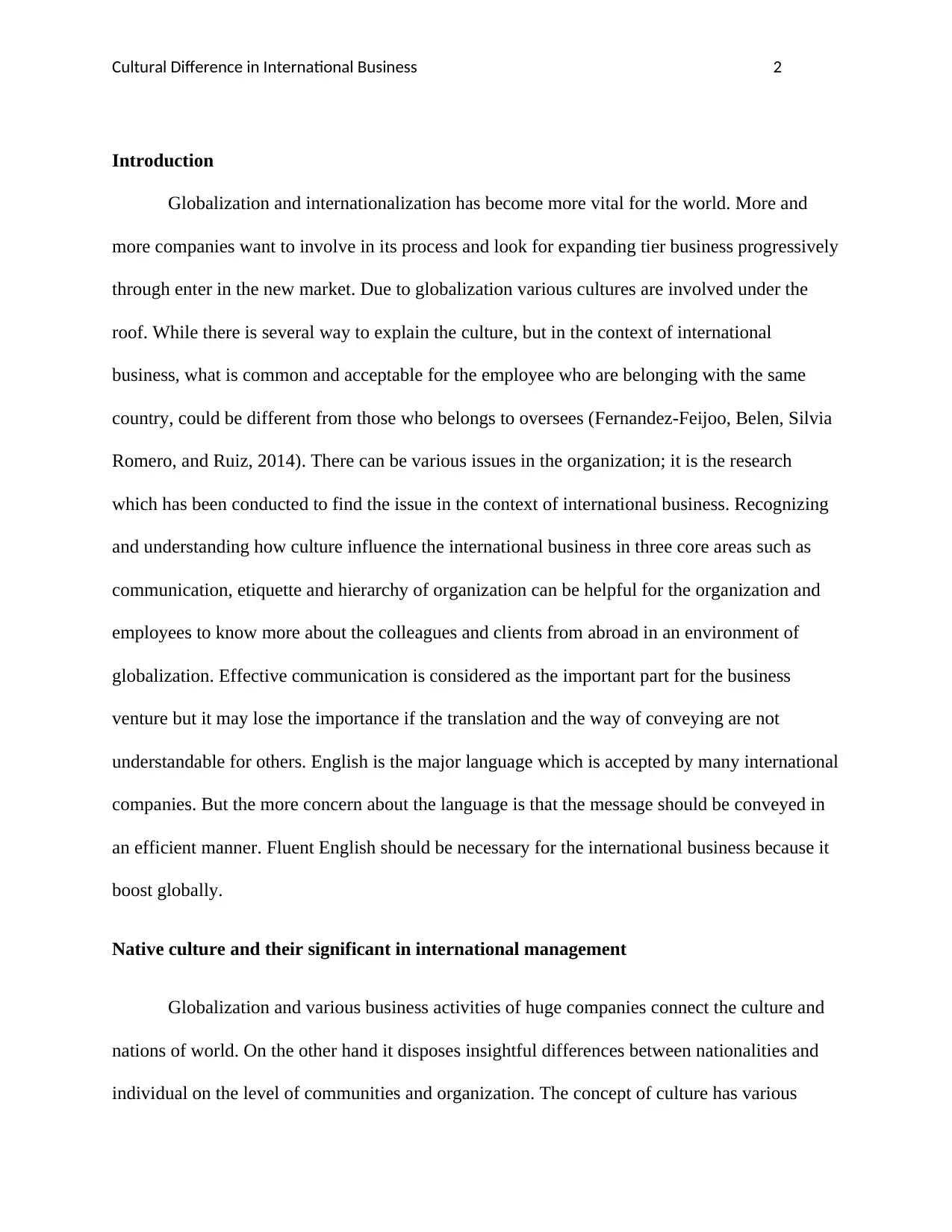
Cultural Difference in International Business 2
Introduction
Globalization and internationalization has become more vital for the world. More and
more companies want to involve in its process and look for expanding tier business progressively
through enter in the new market. Due to globalization various cultures are involved under the
roof. While there is several way to explain the culture, but in the context of international
business, what is common and acceptable for the employee who are belonging with the same
country, could be different from those who belongs to oversees (Fernandez-Feijoo, Belen, Silvia
Romero, and Ruiz, 2014). There can be various issues in the organization; it is the research
which has been conducted to find the issue in the context of international business. Recognizing
and understanding how culture influence the international business in three core areas such as
communication, etiquette and hierarchy of organization can be helpful for the organization and
employees to know more about the colleagues and clients from abroad in an environment of
globalization. Effective communication is considered as the important part for the business
venture but it may lose the importance if the translation and the way of conveying are not
understandable for others. English is the major language which is accepted by many international
companies. But the more concern about the language is that the message should be conveyed in
an efficient manner. Fluent English should be necessary for the international business because it
boost globally.
Native culture and their significant in international management
Globalization and various business activities of huge companies connect the culture and
nations of world. On the other hand it disposes insightful differences between nationalities and
individual on the level of communities and organization. The concept of culture has various
Introduction
Globalization and internationalization has become more vital for the world. More and
more companies want to involve in its process and look for expanding tier business progressively
through enter in the new market. Due to globalization various cultures are involved under the
roof. While there is several way to explain the culture, but in the context of international
business, what is common and acceptable for the employee who are belonging with the same
country, could be different from those who belongs to oversees (Fernandez-Feijoo, Belen, Silvia
Romero, and Ruiz, 2014). There can be various issues in the organization; it is the research
which has been conducted to find the issue in the context of international business. Recognizing
and understanding how culture influence the international business in three core areas such as
communication, etiquette and hierarchy of organization can be helpful for the organization and
employees to know more about the colleagues and clients from abroad in an environment of
globalization. Effective communication is considered as the important part for the business
venture but it may lose the importance if the translation and the way of conveying are not
understandable for others. English is the major language which is accepted by many international
companies. But the more concern about the language is that the message should be conveyed in
an efficient manner. Fluent English should be necessary for the international business because it
boost globally.
Native culture and their significant in international management
Globalization and various business activities of huge companies connect the culture and
nations of world. On the other hand it disposes insightful differences between nationalities and
individual on the level of communities and organization. The concept of culture has various
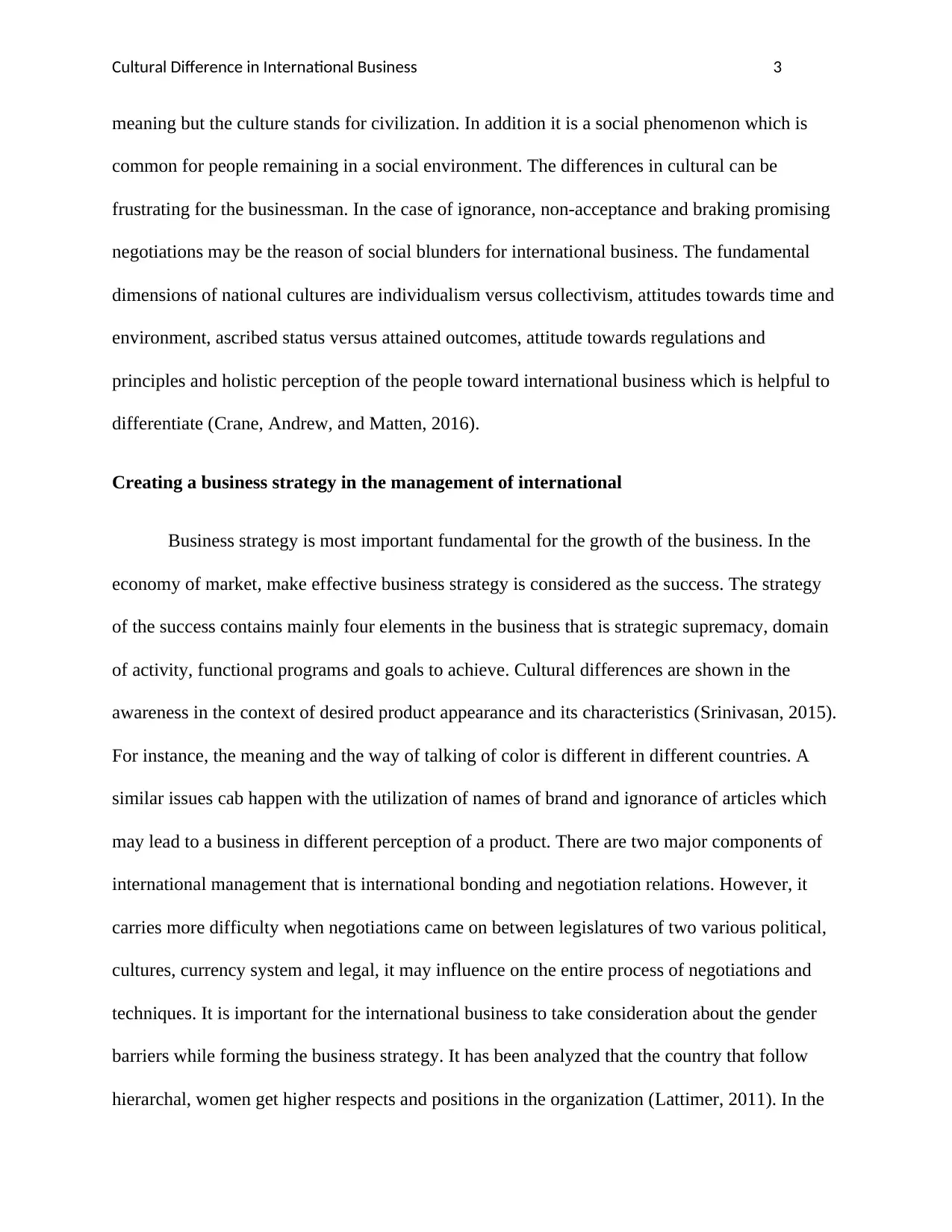
Cultural Difference in International Business 3
meaning but the culture stands for civilization. In addition it is a social phenomenon which is
common for people remaining in a social environment. The differences in cultural can be
frustrating for the businessman. In the case of ignorance, non-acceptance and braking promising
negotiations may be the reason of social blunders for international business. The fundamental
dimensions of national cultures are individualism versus collectivism, attitudes towards time and
environment, ascribed status versus attained outcomes, attitude towards regulations and
principles and holistic perception of the people toward international business which is helpful to
differentiate (Crane, Andrew, and Matten, 2016).
Creating a business strategy in the management of international
Business strategy is most important fundamental for the growth of the business. In the
economy of market, make effective business strategy is considered as the success. The strategy
of the success contains mainly four elements in the business that is strategic supremacy, domain
of activity, functional programs and goals to achieve. Cultural differences are shown in the
awareness in the context of desired product appearance and its characteristics (Srinivasan, 2015).
For instance, the meaning and the way of talking of color is different in different countries. A
similar issues cab happen with the utilization of names of brand and ignorance of articles which
may lead to a business in different perception of a product. There are two major components of
international management that is international bonding and negotiation relations. However, it
carries more difficulty when negotiations came on between legislatures of two various political,
cultures, currency system and legal, it may influence on the entire process of negotiations and
techniques. It is important for the international business to take consideration about the gender
barriers while forming the business strategy. It has been analyzed that the country that follow
hierarchal, women get higher respects and positions in the organization (Lattimer, 2011). In the
meaning but the culture stands for civilization. In addition it is a social phenomenon which is
common for people remaining in a social environment. The differences in cultural can be
frustrating for the businessman. In the case of ignorance, non-acceptance and braking promising
negotiations may be the reason of social blunders for international business. The fundamental
dimensions of national cultures are individualism versus collectivism, attitudes towards time and
environment, ascribed status versus attained outcomes, attitude towards regulations and
principles and holistic perception of the people toward international business which is helpful to
differentiate (Crane, Andrew, and Matten, 2016).
Creating a business strategy in the management of international
Business strategy is most important fundamental for the growth of the business. In the
economy of market, make effective business strategy is considered as the success. The strategy
of the success contains mainly four elements in the business that is strategic supremacy, domain
of activity, functional programs and goals to achieve. Cultural differences are shown in the
awareness in the context of desired product appearance and its characteristics (Srinivasan, 2015).
For instance, the meaning and the way of talking of color is different in different countries. A
similar issues cab happen with the utilization of names of brand and ignorance of articles which
may lead to a business in different perception of a product. There are two major components of
international management that is international bonding and negotiation relations. However, it
carries more difficulty when negotiations came on between legislatures of two various political,
cultures, currency system and legal, it may influence on the entire process of negotiations and
techniques. It is important for the international business to take consideration about the gender
barriers while forming the business strategy. It has been analyzed that the country that follow
hierarchal, women get higher respects and positions in the organization (Lattimer, 2011). In the
⊘ This is a preview!⊘
Do you want full access?
Subscribe today to unlock all pages.

Trusted by 1+ million students worldwide
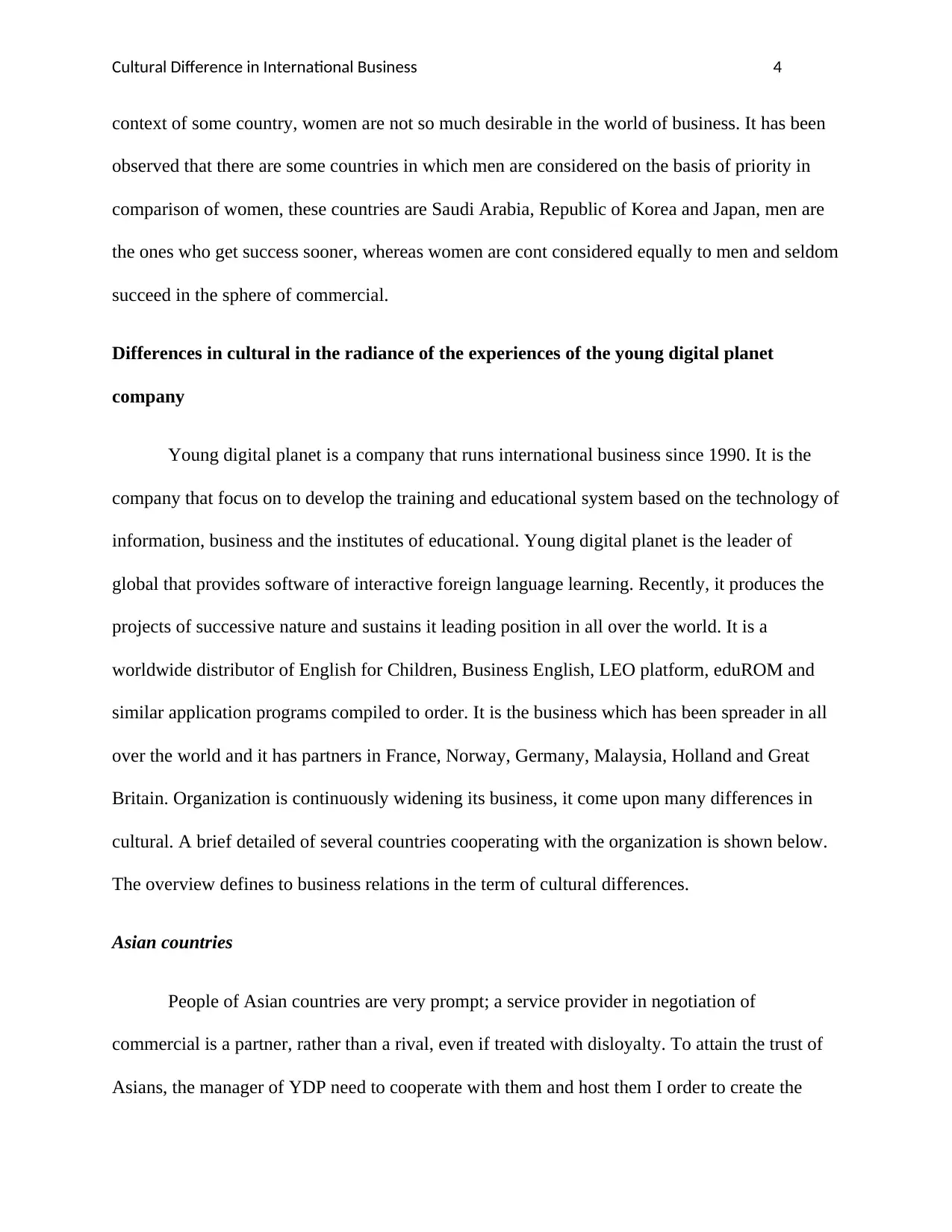
Cultural Difference in International Business 4
context of some country, women are not so much desirable in the world of business. It has been
observed that there are some countries in which men are considered on the basis of priority in
comparison of women, these countries are Saudi Arabia, Republic of Korea and Japan, men are
the ones who get success sooner, whereas women are cont considered equally to men and seldom
succeed in the sphere of commercial.
Differences in cultural in the radiance of the experiences of the young digital planet
company
Young digital planet is a company that runs international business since 1990. It is the
company that focus on to develop the training and educational system based on the technology of
information, business and the institutes of educational. Young digital planet is the leader of
global that provides software of interactive foreign language learning. Recently, it produces the
projects of successive nature and sustains it leading position in all over the world. It is a
worldwide distributor of English for Children, Business English, LEO platform, eduROM and
similar application programs compiled to order. It is the business which has been spreader in all
over the world and it has partners in France, Norway, Germany, Malaysia, Holland and Great
Britain. Organization is continuously widening its business, it come upon many differences in
cultural. A brief detailed of several countries cooperating with the organization is shown below.
The overview defines to business relations in the term of cultural differences.
Asian countries
People of Asian countries are very prompt; a service provider in negotiation of
commercial is a partner, rather than a rival, even if treated with disloyalty. To attain the trust of
Asians, the manager of YDP need to cooperate with them and host them I order to create the
context of some country, women are not so much desirable in the world of business. It has been
observed that there are some countries in which men are considered on the basis of priority in
comparison of women, these countries are Saudi Arabia, Republic of Korea and Japan, men are
the ones who get success sooner, whereas women are cont considered equally to men and seldom
succeed in the sphere of commercial.
Differences in cultural in the radiance of the experiences of the young digital planet
company
Young digital planet is a company that runs international business since 1990. It is the
company that focus on to develop the training and educational system based on the technology of
information, business and the institutes of educational. Young digital planet is the leader of
global that provides software of interactive foreign language learning. Recently, it produces the
projects of successive nature and sustains it leading position in all over the world. It is a
worldwide distributor of English for Children, Business English, LEO platform, eduROM and
similar application programs compiled to order. It is the business which has been spreader in all
over the world and it has partners in France, Norway, Germany, Malaysia, Holland and Great
Britain. Organization is continuously widening its business, it come upon many differences in
cultural. A brief detailed of several countries cooperating with the organization is shown below.
The overview defines to business relations in the term of cultural differences.
Asian countries
People of Asian countries are very prompt; a service provider in negotiation of
commercial is a partner, rather than a rival, even if treated with disloyalty. To attain the trust of
Asians, the manager of YDP need to cooperate with them and host them I order to create the
Paraphrase This Document
Need a fresh take? Get an instant paraphrase of this document with our AI Paraphraser
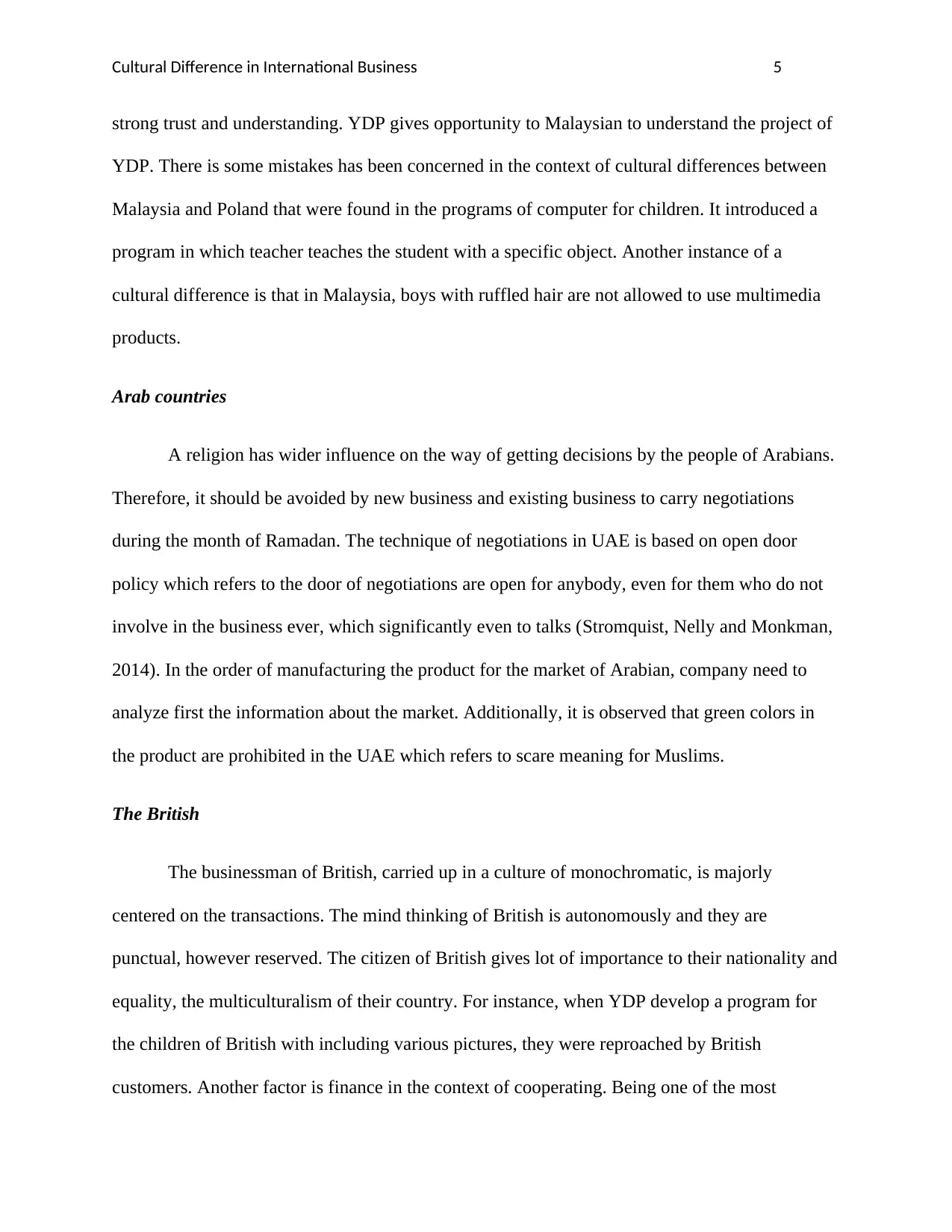
Cultural Difference in International Business 5
strong trust and understanding. YDP gives opportunity to Malaysian to understand the project of
YDP. There is some mistakes has been concerned in the context of cultural differences between
Malaysia and Poland that were found in the programs of computer for children. It introduced a
program in which teacher teaches the student with a specific object. Another instance of a
cultural difference is that in Malaysia, boys with ruffled hair are not allowed to use multimedia
products.
Arab countries
A religion has wider influence on the way of getting decisions by the people of Arabians.
Therefore, it should be avoided by new business and existing business to carry negotiations
during the month of Ramadan. The technique of negotiations in UAE is based on open door
policy which refers to the door of negotiations are open for anybody, even for them who do not
involve in the business ever, which significantly even to talks (Stromquist, Nelly and Monkman,
2014). In the order of manufacturing the product for the market of Arabian, company need to
analyze first the information about the market. Additionally, it is observed that green colors in
the product are prohibited in the UAE which refers to scare meaning for Muslims.
The British
The businessman of British, carried up in a culture of monochromatic, is majorly
centered on the transactions. The mind thinking of British is autonomously and they are
punctual, however reserved. The citizen of British gives lot of importance to their nationality and
equality, the multiculturalism of their country. For instance, when YDP develop a program for
the children of British with including various pictures, they were reproached by British
customers. Another factor is finance in the context of cooperating. Being one of the most
strong trust and understanding. YDP gives opportunity to Malaysian to understand the project of
YDP. There is some mistakes has been concerned in the context of cultural differences between
Malaysia and Poland that were found in the programs of computer for children. It introduced a
program in which teacher teaches the student with a specific object. Another instance of a
cultural difference is that in Malaysia, boys with ruffled hair are not allowed to use multimedia
products.
Arab countries
A religion has wider influence on the way of getting decisions by the people of Arabians.
Therefore, it should be avoided by new business and existing business to carry negotiations
during the month of Ramadan. The technique of negotiations in UAE is based on open door
policy which refers to the door of negotiations are open for anybody, even for them who do not
involve in the business ever, which significantly even to talks (Stromquist, Nelly and Monkman,
2014). In the order of manufacturing the product for the market of Arabian, company need to
analyze first the information about the market. Additionally, it is observed that green colors in
the product are prohibited in the UAE which refers to scare meaning for Muslims.
The British
The businessman of British, carried up in a culture of monochromatic, is majorly
centered on the transactions. The mind thinking of British is autonomously and they are
punctual, however reserved. The citizen of British gives lot of importance to their nationality and
equality, the multiculturalism of their country. For instance, when YDP develop a program for
the children of British with including various pictures, they were reproached by British
customers. Another factor is finance in the context of cooperating. Being one of the most
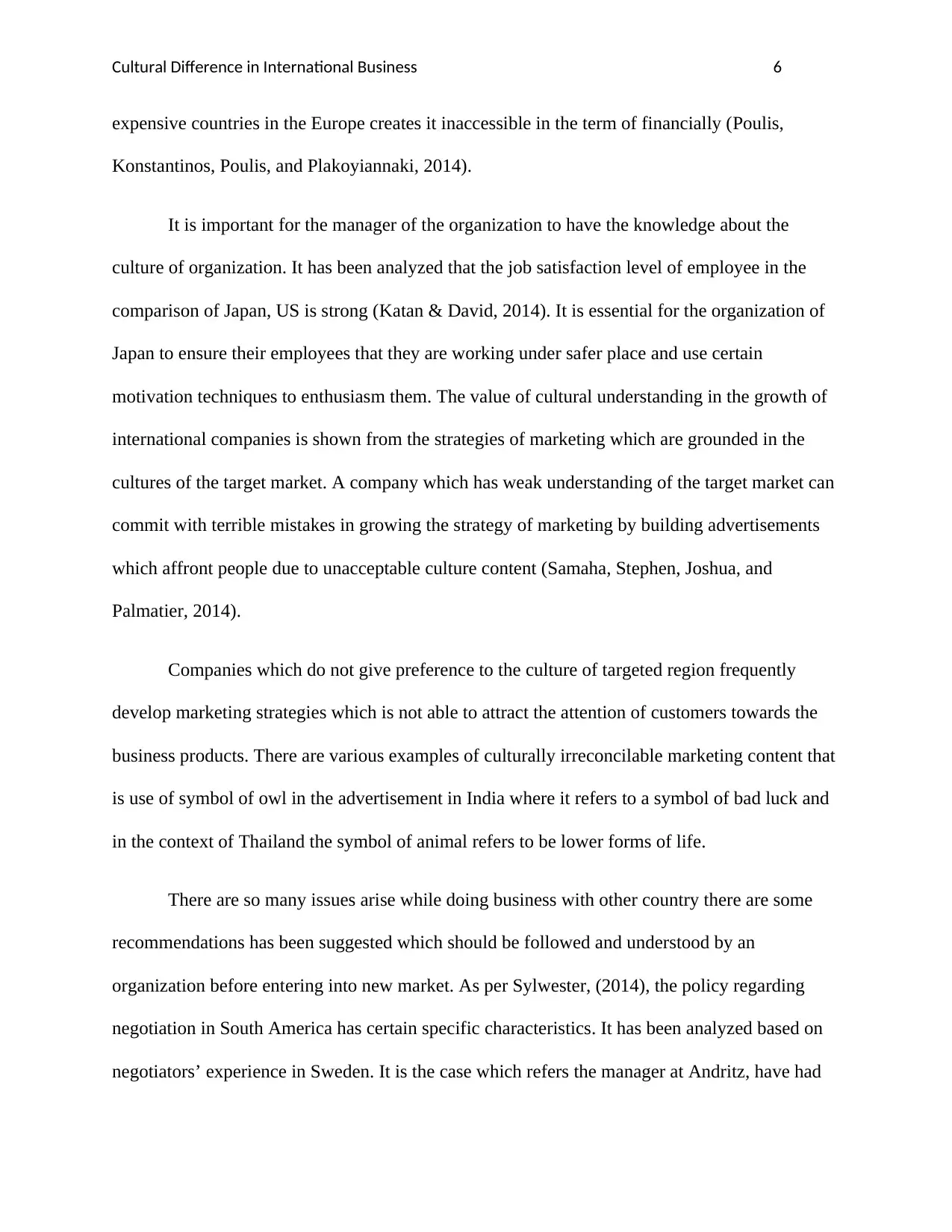
Cultural Difference in International Business 6
expensive countries in the Europe creates it inaccessible in the term of financially (Poulis,
Konstantinos, Poulis, and Plakoyiannaki, 2014).
It is important for the manager of the organization to have the knowledge about the
culture of organization. It has been analyzed that the job satisfaction level of employee in the
comparison of Japan, US is strong (Katan & David, 2014). It is essential for the organization of
Japan to ensure their employees that they are working under safer place and use certain
motivation techniques to enthusiasm them. The value of cultural understanding in the growth of
international companies is shown from the strategies of marketing which are grounded in the
cultures of the target market. A company which has weak understanding of the target market can
commit with terrible mistakes in growing the strategy of marketing by building advertisements
which affront people due to unacceptable culture content (Samaha, Stephen, Joshua, and
Palmatier, 2014).
Companies which do not give preference to the culture of targeted region frequently
develop marketing strategies which is not able to attract the attention of customers towards the
business products. There are various examples of culturally irreconcilable marketing content that
is use of symbol of owl in the advertisement in India where it refers to a symbol of bad luck and
in the context of Thailand the symbol of animal refers to be lower forms of life.
There are so many issues arise while doing business with other country there are some
recommendations has been suggested which should be followed and understood by an
organization before entering into new market. As per Sylwester, (2014), the policy regarding
negotiation in South America has certain specific characteristics. It has been analyzed based on
negotiators’ experience in Sweden. It is the case which refers the manager at Andritz, have had
expensive countries in the Europe creates it inaccessible in the term of financially (Poulis,
Konstantinos, Poulis, and Plakoyiannaki, 2014).
It is important for the manager of the organization to have the knowledge about the
culture of organization. It has been analyzed that the job satisfaction level of employee in the
comparison of Japan, US is strong (Katan & David, 2014). It is essential for the organization of
Japan to ensure their employees that they are working under safer place and use certain
motivation techniques to enthusiasm them. The value of cultural understanding in the growth of
international companies is shown from the strategies of marketing which are grounded in the
cultures of the target market. A company which has weak understanding of the target market can
commit with terrible mistakes in growing the strategy of marketing by building advertisements
which affront people due to unacceptable culture content (Samaha, Stephen, Joshua, and
Palmatier, 2014).
Companies which do not give preference to the culture of targeted region frequently
develop marketing strategies which is not able to attract the attention of customers towards the
business products. There are various examples of culturally irreconcilable marketing content that
is use of symbol of owl in the advertisement in India where it refers to a symbol of bad luck and
in the context of Thailand the symbol of animal refers to be lower forms of life.
There are so many issues arise while doing business with other country there are some
recommendations has been suggested which should be followed and understood by an
organization before entering into new market. As per Sylwester, (2014), the policy regarding
negotiation in South America has certain specific characteristics. It has been analyzed based on
negotiators’ experience in Sweden. It is the case which refers the manager at Andritz, have had
⊘ This is a preview!⊘
Do you want full access?
Subscribe today to unlock all pages.

Trusted by 1+ million students worldwide
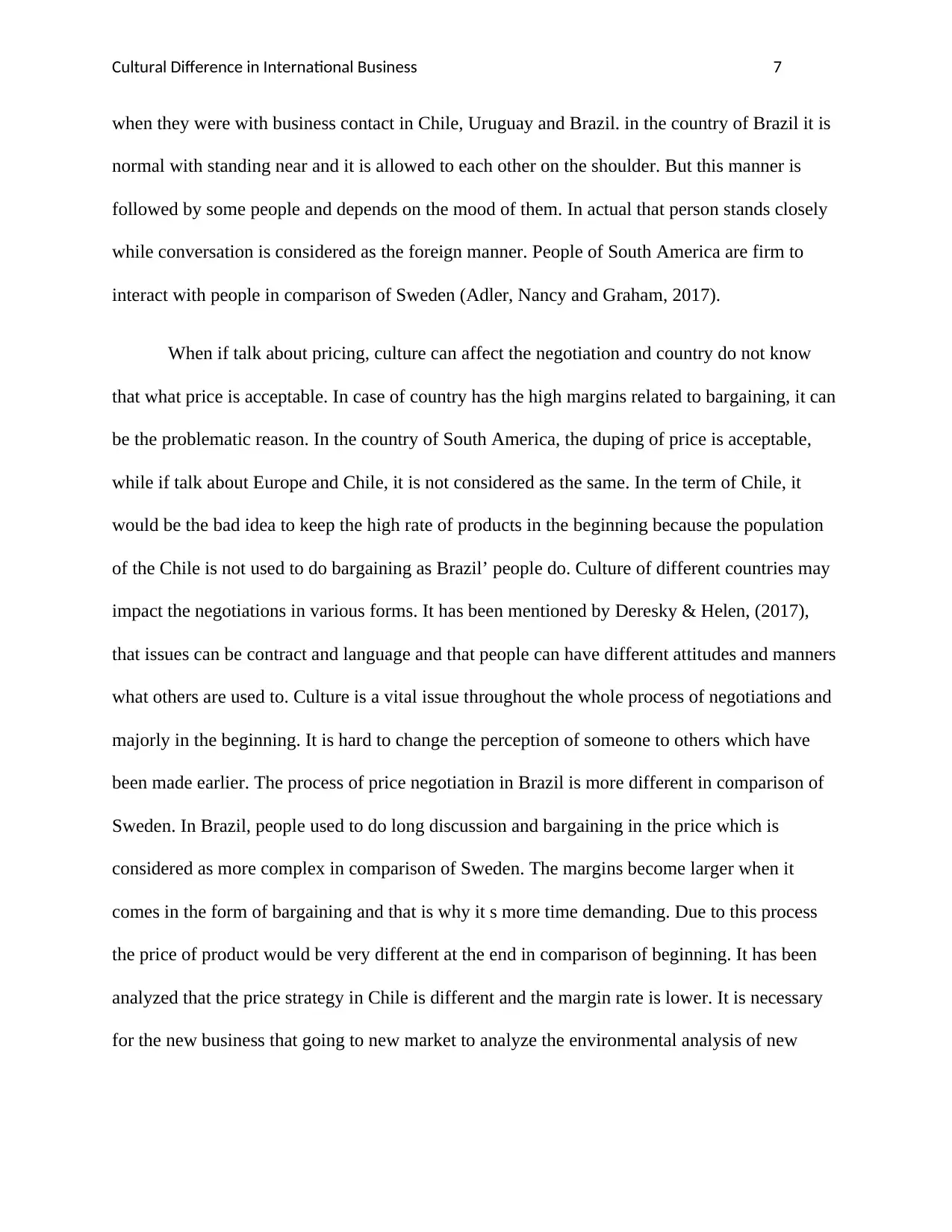
Cultural Difference in International Business 7
when they were with business contact in Chile, Uruguay and Brazil. in the country of Brazil it is
normal with standing near and it is allowed to each other on the shoulder. But this manner is
followed by some people and depends on the mood of them. In actual that person stands closely
while conversation is considered as the foreign manner. People of South America are firm to
interact with people in comparison of Sweden (Adler, Nancy and Graham, 2017).
When if talk about pricing, culture can affect the negotiation and country do not know
that what price is acceptable. In case of country has the high margins related to bargaining, it can
be the problematic reason. In the country of South America, the duping of price is acceptable,
while if talk about Europe and Chile, it is not considered as the same. In the term of Chile, it
would be the bad idea to keep the high rate of products in the beginning because the population
of the Chile is not used to do bargaining as Brazil’ people do. Culture of different countries may
impact the negotiations in various forms. It has been mentioned by Deresky & Helen, (2017),
that issues can be contract and language and that people can have different attitudes and manners
what others are used to. Culture is a vital issue throughout the whole process of negotiations and
majorly in the beginning. It is hard to change the perception of someone to others which have
been made earlier. The process of price negotiation in Brazil is more different in comparison of
Sweden. In Brazil, people used to do long discussion and bargaining in the price which is
considered as more complex in comparison of Sweden. The margins become larger when it
comes in the form of bargaining and that is why it s more time demanding. Due to this process
the price of product would be very different at the end in comparison of beginning. It has been
analyzed that the price strategy in Chile is different and the margin rate is lower. It is necessary
for the new business that going to new market to analyze the environmental analysis of new
when they were with business contact in Chile, Uruguay and Brazil. in the country of Brazil it is
normal with standing near and it is allowed to each other on the shoulder. But this manner is
followed by some people and depends on the mood of them. In actual that person stands closely
while conversation is considered as the foreign manner. People of South America are firm to
interact with people in comparison of Sweden (Adler, Nancy and Graham, 2017).
When if talk about pricing, culture can affect the negotiation and country do not know
that what price is acceptable. In case of country has the high margins related to bargaining, it can
be the problematic reason. In the country of South America, the duping of price is acceptable,
while if talk about Europe and Chile, it is not considered as the same. In the term of Chile, it
would be the bad idea to keep the high rate of products in the beginning because the population
of the Chile is not used to do bargaining as Brazil’ people do. Culture of different countries may
impact the negotiations in various forms. It has been mentioned by Deresky & Helen, (2017),
that issues can be contract and language and that people can have different attitudes and manners
what others are used to. Culture is a vital issue throughout the whole process of negotiations and
majorly in the beginning. It is hard to change the perception of someone to others which have
been made earlier. The process of price negotiation in Brazil is more different in comparison of
Sweden. In Brazil, people used to do long discussion and bargaining in the price which is
considered as more complex in comparison of Sweden. The margins become larger when it
comes in the form of bargaining and that is why it s more time demanding. Due to this process
the price of product would be very different at the end in comparison of beginning. It has been
analyzed that the price strategy in Chile is different and the margin rate is lower. It is necessary
for the new business that going to new market to analyze the environmental analysis of new
Paraphrase This Document
Need a fresh take? Get an instant paraphrase of this document with our AI Paraphraser

Cultural Difference in International Business 8
market and set the targeted market. Differentiation in culture may hamper the situation of an
organization (Moran, Robert , Abramson, and Moran, 2017).
market and set the targeted market. Differentiation in culture may hamper the situation of an
organization (Moran, Robert , Abramson, and Moran, 2017).
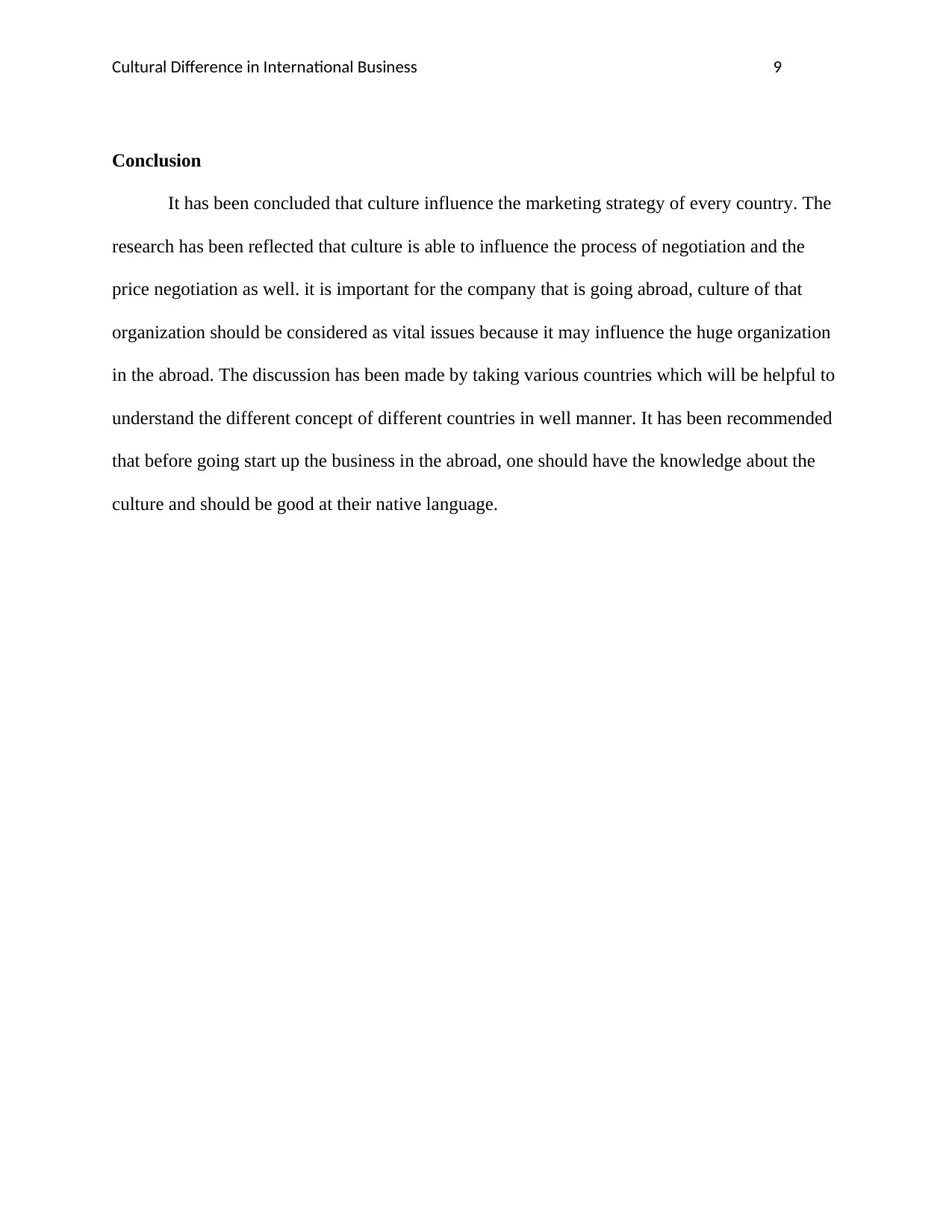
Cultural Difference in International Business 9
Conclusion
It has been concluded that culture influence the marketing strategy of every country. The
research has been reflected that culture is able to influence the process of negotiation and the
price negotiation as well. it is important for the company that is going abroad, culture of that
organization should be considered as vital issues because it may influence the huge organization
in the abroad. The discussion has been made by taking various countries which will be helpful to
understand the different concept of different countries in well manner. It has been recommended
that before going start up the business in the abroad, one should have the knowledge about the
culture and should be good at their native language.
Conclusion
It has been concluded that culture influence the marketing strategy of every country. The
research has been reflected that culture is able to influence the process of negotiation and the
price negotiation as well. it is important for the company that is going abroad, culture of that
organization should be considered as vital issues because it may influence the huge organization
in the abroad. The discussion has been made by taking various countries which will be helpful to
understand the different concept of different countries in well manner. It has been recommended
that before going start up the business in the abroad, one should have the knowledge about the
culture and should be good at their native language.
⊘ This is a preview!⊘
Do you want full access?
Subscribe today to unlock all pages.

Trusted by 1+ million students worldwide
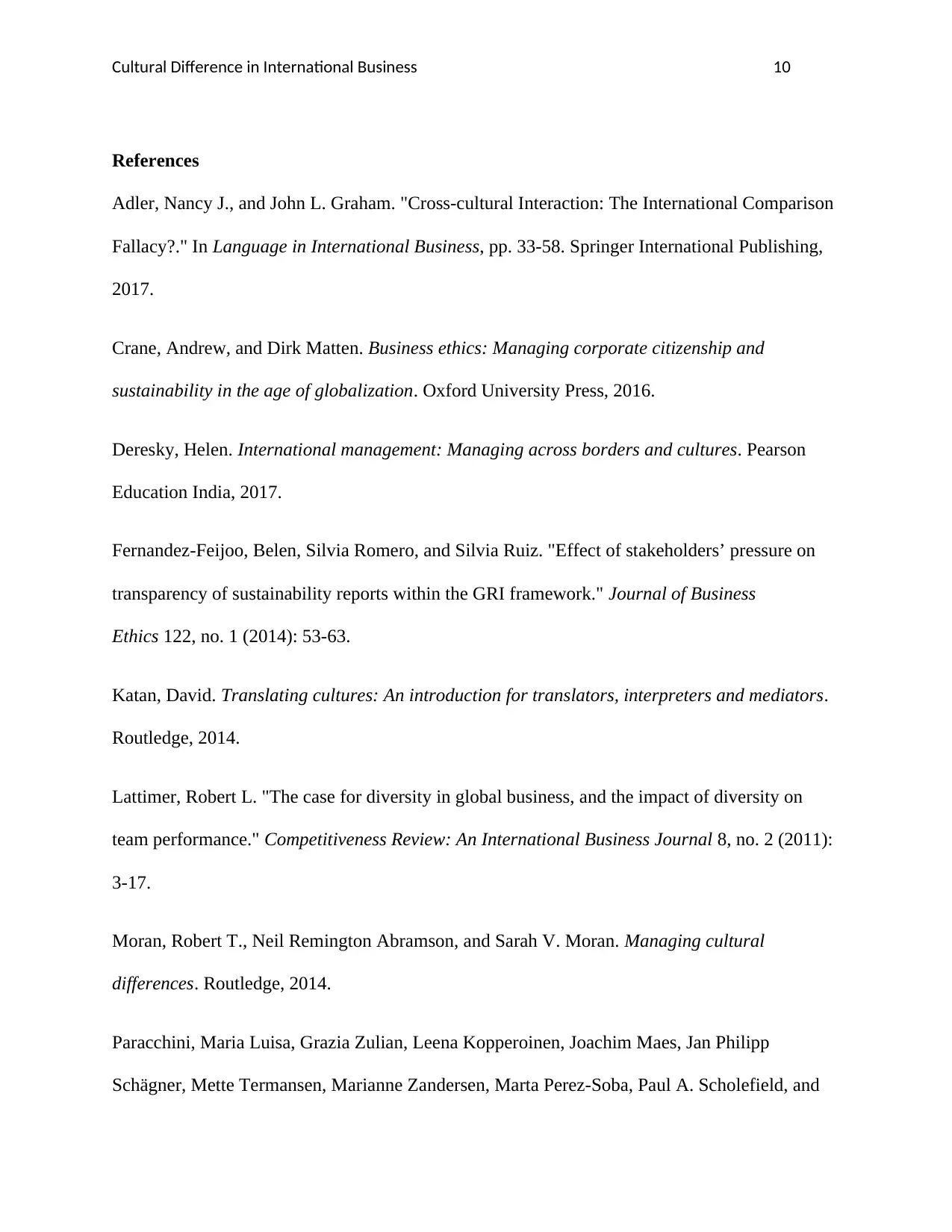
Cultural Difference in International Business 10
References
Adler, Nancy J., and John L. Graham. "Cross-cultural Interaction: The International Comparison
Fallacy?." In Language in International Business, pp. 33-58. Springer International Publishing,
2017.
Crane, Andrew, and Dirk Matten. Business ethics: Managing corporate citizenship and
sustainability in the age of globalization. Oxford University Press, 2016.
Deresky, Helen. International management: Managing across borders and cultures. Pearson
Education India, 2017.
Fernandez-Feijoo, Belen, Silvia Romero, and Silvia Ruiz. "Effect of stakeholders’ pressure on
transparency of sustainability reports within the GRI framework." Journal of Business
Ethics 122, no. 1 (2014): 53-63.
Katan, David. Translating cultures: An introduction for translators, interpreters and mediators.
Routledge, 2014.
Lattimer, Robert L. "The case for diversity in global business, and the impact of diversity on
team performance." Competitiveness Review: An International Business Journal 8, no. 2 (2011):
3-17.
Moran, Robert T., Neil Remington Abramson, and Sarah V. Moran. Managing cultural
differences. Routledge, 2014.
Paracchini, Maria Luisa, Grazia Zulian, Leena Kopperoinen, Joachim Maes, Jan Philipp
Schägner, Mette Termansen, Marianne Zandersen, Marta Perez-Soba, Paul A. Scholefield, and
References
Adler, Nancy J., and John L. Graham. "Cross-cultural Interaction: The International Comparison
Fallacy?." In Language in International Business, pp. 33-58. Springer International Publishing,
2017.
Crane, Andrew, and Dirk Matten. Business ethics: Managing corporate citizenship and
sustainability in the age of globalization. Oxford University Press, 2016.
Deresky, Helen. International management: Managing across borders and cultures. Pearson
Education India, 2017.
Fernandez-Feijoo, Belen, Silvia Romero, and Silvia Ruiz. "Effect of stakeholders’ pressure on
transparency of sustainability reports within the GRI framework." Journal of Business
Ethics 122, no. 1 (2014): 53-63.
Katan, David. Translating cultures: An introduction for translators, interpreters and mediators.
Routledge, 2014.
Lattimer, Robert L. "The case for diversity in global business, and the impact of diversity on
team performance." Competitiveness Review: An International Business Journal 8, no. 2 (2011):
3-17.
Moran, Robert T., Neil Remington Abramson, and Sarah V. Moran. Managing cultural
differences. Routledge, 2014.
Paracchini, Maria Luisa, Grazia Zulian, Leena Kopperoinen, Joachim Maes, Jan Philipp
Schägner, Mette Termansen, Marianne Zandersen, Marta Perez-Soba, Paul A. Scholefield, and
Paraphrase This Document
Need a fresh take? Get an instant paraphrase of this document with our AI Paraphraser
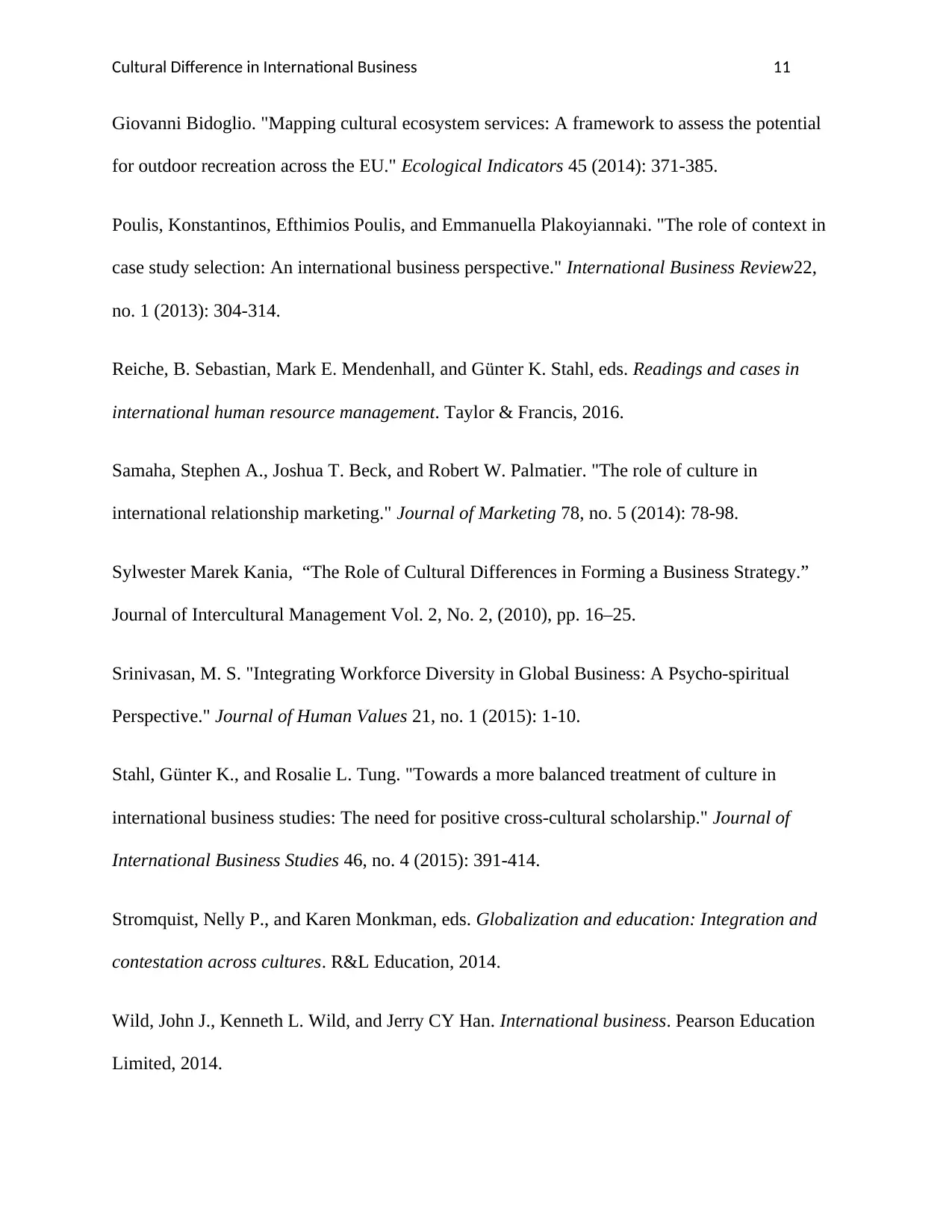
Cultural Difference in International Business 11
Giovanni Bidoglio. "Mapping cultural ecosystem services: A framework to assess the potential
for outdoor recreation across the EU." Ecological Indicators 45 (2014): 371-385.
Poulis, Konstantinos, Efthimios Poulis, and Emmanuella Plakoyiannaki. "The role of context in
case study selection: An international business perspective." International Business Review22,
no. 1 (2013): 304-314.
Reiche, B. Sebastian, Mark E. Mendenhall, and Günter K. Stahl, eds. Readings and cases in
international human resource management. Taylor & Francis, 2016.
Samaha, Stephen A., Joshua T. Beck, and Robert W. Palmatier. "The role of culture in
international relationship marketing." Journal of Marketing 78, no. 5 (2014): 78-98.
Sylwester Marek Kania, “The Role of Cultural Differences in Forming a Business Strategy.”
Journal of Intercultural Management Vol. 2, No. 2, (2010), pp. 16–25.
Srinivasan, M. S. "Integrating Workforce Diversity in Global Business: A Psycho-spiritual
Perspective." Journal of Human Values 21, no. 1 (2015): 1-10.
Stahl, Günter K., and Rosalie L. Tung. "Towards a more balanced treatment of culture in
international business studies: The need for positive cross-cultural scholarship." Journal of
International Business Studies 46, no. 4 (2015): 391-414.
Stromquist, Nelly P., and Karen Monkman, eds. Globalization and education: Integration and
contestation across cultures. R&L Education, 2014.
Wild, John J., Kenneth L. Wild, and Jerry CY Han. International business. Pearson Education
Limited, 2014.
Giovanni Bidoglio. "Mapping cultural ecosystem services: A framework to assess the potential
for outdoor recreation across the EU." Ecological Indicators 45 (2014): 371-385.
Poulis, Konstantinos, Efthimios Poulis, and Emmanuella Plakoyiannaki. "The role of context in
case study selection: An international business perspective." International Business Review22,
no. 1 (2013): 304-314.
Reiche, B. Sebastian, Mark E. Mendenhall, and Günter K. Stahl, eds. Readings and cases in
international human resource management. Taylor & Francis, 2016.
Samaha, Stephen A., Joshua T. Beck, and Robert W. Palmatier. "The role of culture in
international relationship marketing." Journal of Marketing 78, no. 5 (2014): 78-98.
Sylwester Marek Kania, “The Role of Cultural Differences in Forming a Business Strategy.”
Journal of Intercultural Management Vol. 2, No. 2, (2010), pp. 16–25.
Srinivasan, M. S. "Integrating Workforce Diversity in Global Business: A Psycho-spiritual
Perspective." Journal of Human Values 21, no. 1 (2015): 1-10.
Stahl, Günter K., and Rosalie L. Tung. "Towards a more balanced treatment of culture in
international business studies: The need for positive cross-cultural scholarship." Journal of
International Business Studies 46, no. 4 (2015): 391-414.
Stromquist, Nelly P., and Karen Monkman, eds. Globalization and education: Integration and
contestation across cultures. R&L Education, 2014.
Wild, John J., Kenneth L. Wild, and Jerry CY Han. International business. Pearson Education
Limited, 2014.

Cultural Difference in International Business 12
⊘ This is a preview!⊘
Do you want full access?
Subscribe today to unlock all pages.

Trusted by 1+ million students worldwide
1 out of 12
Related Documents
Your All-in-One AI-Powered Toolkit for Academic Success.
+13062052269
info@desklib.com
Available 24*7 on WhatsApp / Email
![[object Object]](/_next/static/media/star-bottom.7253800d.svg)
Unlock your academic potential
Copyright © 2020–2025 A2Z Services. All Rights Reserved. Developed and managed by ZUCOL.





